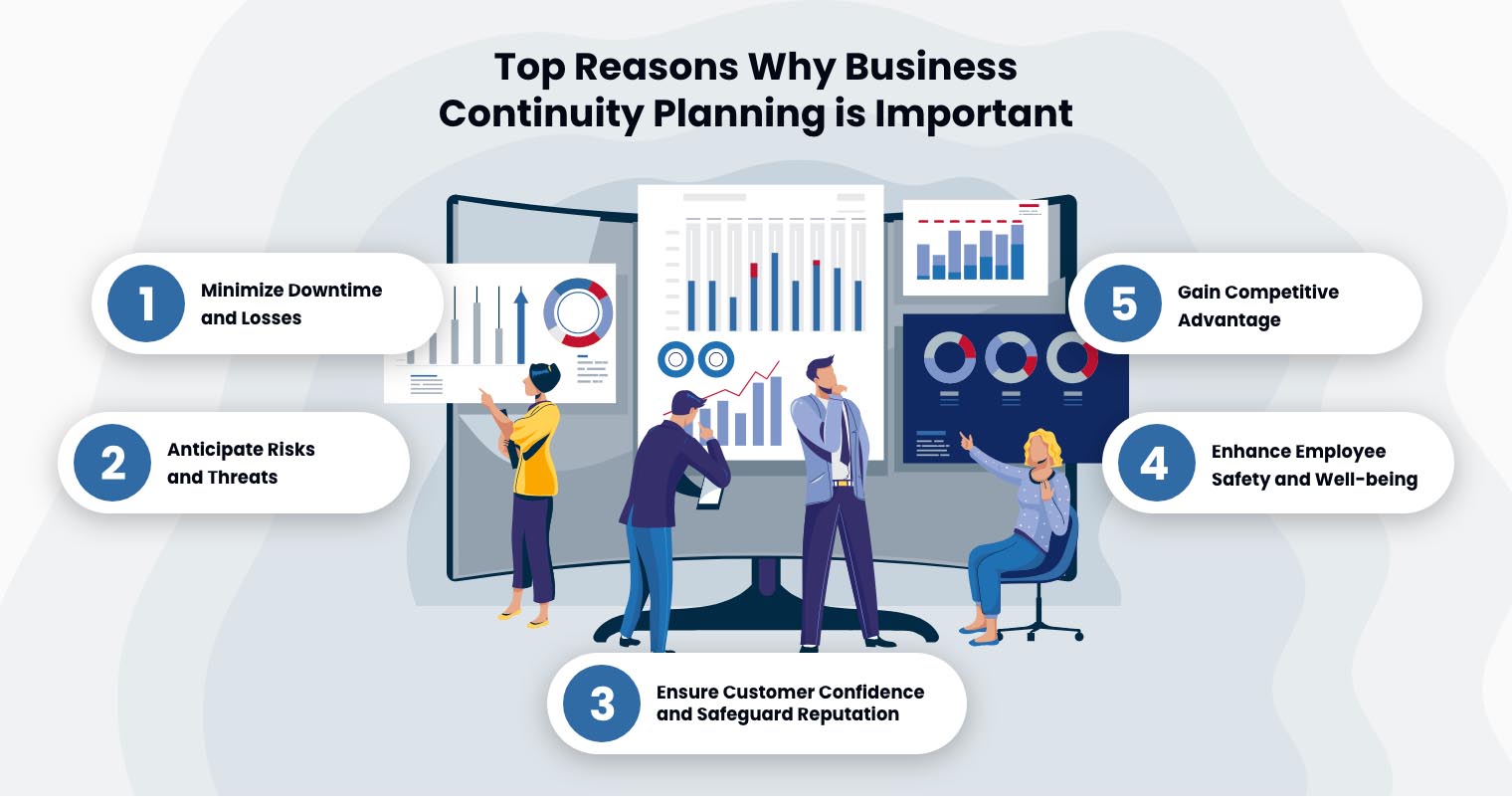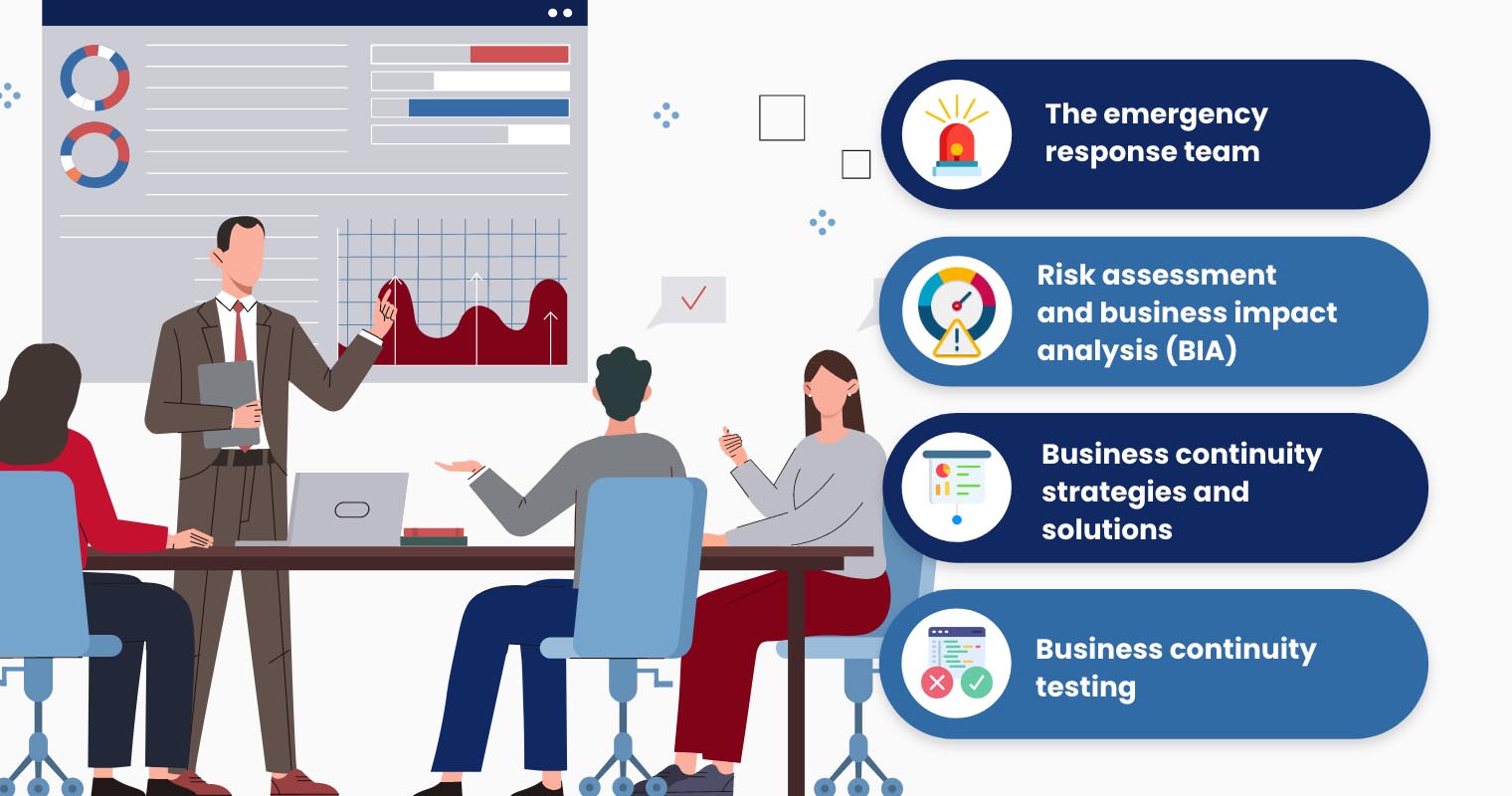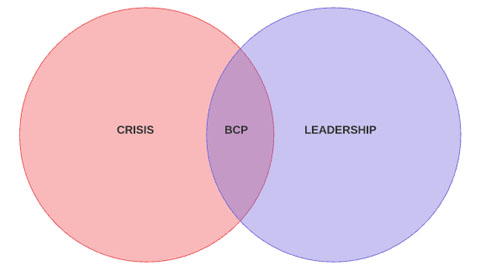Most organizations are no strangers to plans. Whether succession planning, business strategy, or marketing campaigns, planning is vital in ensuring all bases are covered from start to finish.
Among the areas that require planning within an organization, business continuity and disaster recovery stand out as crucial. These aspects are instrumental in maintaining the stability of your business’s skeletal structure and operations, especially during challenging circumstances.
In this article, we will delve into the importance of business continuity planning, its fundamentals, and how it can enhance your company’s resilience.
What is Business Continuity Planning?
Business continuity planning is the development of a strategic management plan to prepare an organization for responding to and recovering from various crises, such as natural disasters, pandemics, or cyberattacks. Inadequate management of a business crisis can lead to significant expenses and reputational damage. Stakeholders are often unforgiving during such times, making it essential to have a well-prepared business continuity plan in place.
What is the importance of a business continuity plan?
A business continuity plan (BCP), which is an executive-approved document for managing disruptions, serves as a definitive blueprint outlining the actions to be taken by everyone involved to maintain operations throughout and after a catastrophe. Specifically, the business continuity plan supports critical aspects such as workflow operations, customer service response, workforce communication, information flow, and business security.
What is the goal of a business continuity plan? It is crucial in mitigating the risks associated with losses and the aftermath of a crisis. Such a plan offers peace of mind to both management and employees, creating a secure work environment where clear policies are in place to guide response and recovery efforts during crises.
Business Continuity Planning vs Disaster Recovery
While natural disasters can trigger crises, business continuity extends beyond disaster recovery. Business continuity encompasses the comprehensive implementation plan that ensures the continuous operation of critical business functions. On the other hand, disaster recovery is a specific component of the business continuity plan that primarily focuses on restoring the organization’s IT infrastructure and data after disruptions.
Top Reasons Why Business Continuity Planning is Important

It is important to understand that a business continuity plan is not merely a backup plan to restore revenue. There are numerous compelling reasons why even small businesses should prioritize preparing such a plan. Let’s explore the key motivations behind initiating your business continuity planning.
1. Minimize Downtime and Losses
Whatever your business goals are or wherever industry, your company cannot afford downtime. Understanding and implementing instantly what to do in case of disruptions is one of the main benefits of a business continuity plan. Remember that the longer the downtime, the higher potential for financial loss.
Business continuity planning makes it possible to keep your business running and mitigate financial loss by establishing actions to take, whatever the nature of the disruption. For instance, if the current physical office becomes inaccessible due to natural disasters, can your system support remote work and resources for employees? Or, if the power goes out and the server or network can’t be accessed, is there a backup server or data center?
A strong business continuity plan takes into account the potential losses when downtime occurs in a matter of minutes to days and weeks. It defines the procedures of how the company should function and continue to be stable to communicate to all stakeholders and customers — eventually, ensuring continuous flow of revenue and trust.
2. Anticipate Risks and Threats
Constant discussion and application of the BCP ensures that the business continuity management team is examining the potential risks, threats, and accidents that the company may face. Disasters are not limited to natural causes. In today’s business, organizations are expected to face a myriad of challenges, from power disruptions and global pandemics to targeted cybercrimes and data destruction.
Proper business continuity planning allows the consideration of all the possible disruptions within your industry, location, and even on a global scale. Identifying these risks may prevent losses by establishing response and recovery procedures.
3. Ensure Customer Confidence and Safeguard Reputation
During times of crisis, your customers become more discerning about your actions and responses. They expect your business to effectively navigate through disaster situations. Resuming operations promptly and effectively after a crisis can significantly contribute to building trust with your customers.
Additionally, your customers represent one of the most valuable assets of your company, and it is crucial to safeguard the information they have entrusted to you. Establishing a contingency plan outlines the necessary measures to take in the event of cyberattacks and data breaches.
Having a robust business continuity plan in place signals to customers that they have made the right choice in selecting your product or service, leading them to continue their patronage. This, in turn, can have a positive impact on your brand reputation. Companies that demonstrate preparedness and consistency in effectively managing crises convey their resilience and stability to their consumers and the world at large.
4. Enhance Employee Safety and Well-being
When a company is affected by disasters or crises, it can be challenging to focus on work. However, in such situations, it is crucial to prioritize the safety and well-being of your workforce. Safety extends beyond physical health and includes mental well-being as well.
Amidst the global pandemic, businesses have experienced widespread disruption, leading many employers to adopt remote work arrangements and implement mental health programs to support their employees. A well-prepared business continuity plan plays a vital role in swiftly accounting for employee safety and providing necessary support for them to continue working during and after crises.
Furthermore, when employees are confident in the plans and decisions made by management, they become more determined and focused on their work. By establishing a well-communicated business continuity plan, you reassure your employees of their safety. This then can enhance employee productivity, improve operational efficiencies, and foster heightened vigilance against security threats.
5. Gain Competitive Advantage
Another benefit of a business continuity plan is gaining a competitive edge over your rivals. Effectively restoring business operations, recovering networks, updating data access, and reconnecting employees to customers all contribute to enhancing corporate governance and positioning your company as a reliable brand. A robust business continuity plan guarantees that you are prepared to navigate disruptions, delivering uninterrupted services that set you apart from the competition.
The Fundamentals of Business Continuity Planning

The purpose of a business continuity plan is to identify, address, and reduce the risk of potential disruptions while maintaining business functions. Below are the key components of business continuity planning:
1. The emergency response team
To initiate the BCP process, it is crucial to form a dedicated response team comprising managers or leaders who can contribute valuable insights. This team holds the responsibility of actively engaging in the recovery process and overseeing specific tasks like restoring systems and operations. It is essential to select individuals who possess the ability to drive progress and make decisions when required.
2. Risk assessment and business impact analysis (BIA)
Before formulating strategies and procedures for your business functions, identify first the potential threats to your business and assess its vulnerable areas. Conducting a business impact analysis enables your company to understand the potential consequences of disruptions and losses on your financial and operational functions. This analysis helps evaluate which resources and assets should be prioritized for recovery and aids in the development of effective recovery procedures.
3. Business continuity strategies and solutions
Based on the risk assessment and analysis conducted, recovery strategies and procedures can be developed to uphold business functions and prioritize resources accordingly. These strategies encompass key components that are crucial for effective recovery:
- Emergency response plan — This entails a comprehensive set of guidelines aimed at minimizing the overall disruption impact on the business and ensuring workforce safety. It should include protocols for emergency response communication, evacuation routes, and emergency contact information.
- Crisis management — This plan outlines the contingency measures for communication, activities of key personnel, incident remediation, and decision-making during a crisis. It ensures that there is a structured approach to managing the crisis effectively.
- Operations restoration — The operational recovery plan focuses on safeguarding human resources and business assets while restoring essential functions following a crisis or emergency. This plan involves determining recovery time objectives, formulating strategies for security measures, work environment restoration, data center recovery, and establishing communication protocols.
4. Business continuity testing
Once the BCP has been formulated and approved, conduct regular tests and updates to ensure its effectiveness. Business continuity planning is not a one-time activity; it is an ongoing process that requires continuous evaluation and improvement. Regular testing improves predictability, minimizes risks, and keeps your plans updated and aligned with the constantly changing business landscape. By consistently reviewing and refining your BCP, you can enhance its reliability and increase the likelihood of successfully navigating through future disruptions.
FAQs About Business Continuity Planning
If you’re seeking to enhance your business continuity plan, explore our FAQs to find answers to your questions.
What is the goal of a business continuity plan?
The main purpose of a business continuity plan is to ensure the organization is prepared to respond to and recover from emergencies and disruptions, such as natural disasters and cyberattacks. This planning is a process of identifying the potential risks and formulating solutions to minimize the negative impact of such risks.
Why is business continuity planning important for preparing for natural disasters?
During natural disasters, business continuity planning proves beneficial to organizations by expediting recovery efforts through implementing mechanisms aimed at mitigating financial risks, minimizing downtime, and ensuring the safety of employees. BCPs encompass comprehensive measures and protocols to address all organizational risks in the event of natural disasters like floods, fires, or earthquakes.
Is business continuity planning only relevant for large organizations?
Of course not! No matter the size — small or enterprise — and wherever industry, every organization must be performing business continuity planning. If an organization does not plan for continuity, the management and workforce are not prepared to react and pick up from the occurrence of disruptions and their negative impacts.
Can business continuity planning help organizations respond to cyberattacks?
Yes! Your business continuity planning must cover every threat to your organization, including cybercrimes. Even with the most advanced security features, you may not be safe from data breaches which may cost you financial and information losses. A solid business continuity plan implements cybersecurity risk assessment to develop strategies for prevention and recovery from cyber threats.
What are the key components of a business continuity plan?
The key components of a BCP are the elements needed from conceptualization to implementation. These key elements include: the crisis management team, risk assessments, business impact analysis, strategies for prevention, response and recovery, and BCP testing.
Download our free actionable guide to business continuity planning to see how these components build your BCP.
How often should a business continuity plan be reviewed and updated?
As a best practice, your BCP must be reviewed and updated annually at a minimum. Business changes, industry changes, and other external factors must also be considered to be promptly reflected when updating the business continuity plan.
Create a Business Continuity Plan with Board Technology

Whether it’s a natural disaster or a cyberattack, unexpected situations can arise. A well-prepared business continuity plan, coupled with the necessary resources, is vital to enable companies to maintain their market positions and swiftly recover from adverse circumstances, ensuring minimal disruption to normal operations.
In the digital era, advanced technologies can play a significant role in developing a comprehensive business continuity plan. This development process should be a collaborative effort, incorporating insights from both management and staff.
To streamline collaboration, consider leveraging Convene, the trusted board management software, equipped with interactive and secure features that facilitate effective planning. Convene empowers meetings with video conferencing capabilities to easily communicate assessments and strategies for business continuity. Moreover, the software allows secure document management to collaborate on risk assessments and reports and store them in a secure, resilient repository.
Explore the many more features of Convene and discover how it can enhance your board meetings, document management, and overall business continuity efforts.
Audrey is a Content Marketing Specialist at Convene, in charge of managing the production of quality content on the company’s website. A communication major keen on marketing, Audrey has been constantly seeking approaches to create tailored content—may it be about governance, digitalization, boards, or meetings—fit for the stakeholders. When not strategizing on the next ebook to produce, Audrey finds solitude in reading make-you-ugly-cry novels and listening to self-improvement podcasts.










